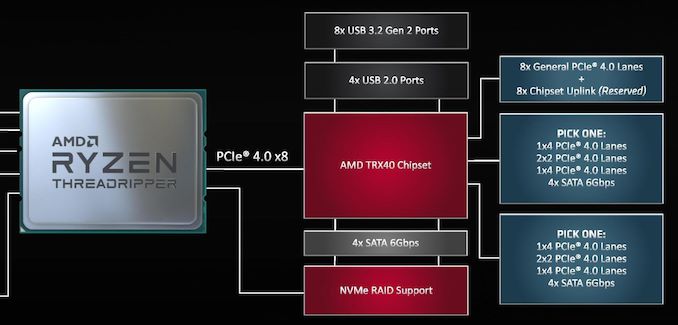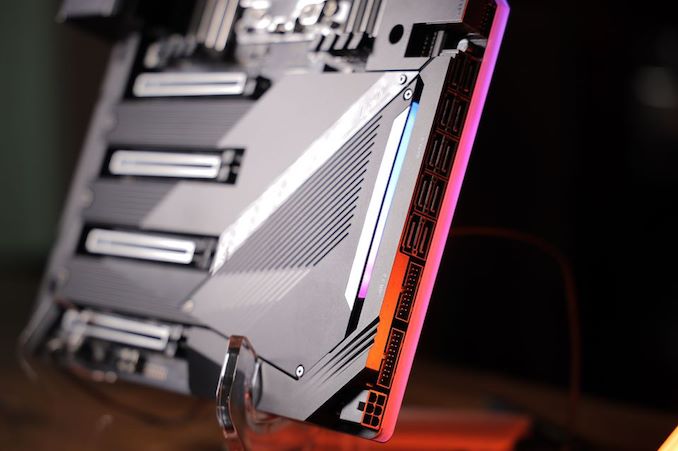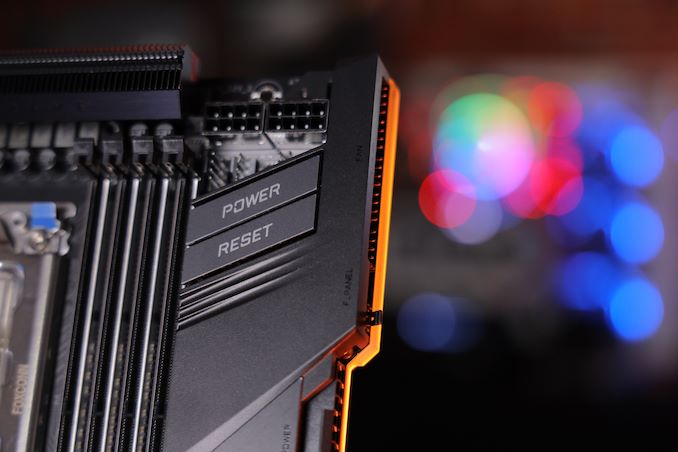AMD Q4: 16-core Ryzen 9 3950X, Threadripper Up To 32-Core 3970X, Coming November 25th
by Dr. Ian Cutress on November 7, 2019 9:00 AM ESTTRX40: More High-End Motherboards for TR3
The new sTRX4 socket will be paired with a TRX40 chipset – a design that AMD says comes from an in-house team and built on GlobalFoundries 14nm. The new chipset, updated from the previous X399 in this space and even updated from the X570 in the consumer space, is the other half in the CPU-to-chipset bandwidth story. By using a PCIe 4.0 x8 link, AMD is removing almost any practical bandwidth limitation downstream from the CPU.
The new TRX40 chipset will come with a degree of modularity.
From the chipset, we can see motherboard manufacturers afforded a full PCIe 4.0 x8 slot, up to another x8 lanes as two x4 connections or further bifurcated, or instead of those bifurcated lanes, either four or eight more SATA ports. That’s 8 SATA ports on top of the four already present on the chipset.
So I like these modular systems. It allows motherboard manufacturers to go crazy with offering potential systems. For example:
| Potential TRX40 Variants | |||||||
| AnandTech | CPU | Chipset | |||||
| TRX40 SATA Powerhouse 20 drives |
x48 for PCIe slots | x8 for downlink | 8x SATA from options | x8 for dual NVMe | 8x SATA from options | 4x SATA from chipset | |
| TRX40 NVMe Powerhouse 18+ drives |
x48 for PCIe slots | x8 for downlink | dual NVMe from options | x8 for dual NVMe | dual NVMe for options | - | |
So that would be a motherboard with x16/x16/x16 (or x16/x8/x16/x8) in terms of PCIe 4.0 slots, a single x8 slot for a pair of NVMe drives, and then TWENTY SATA ports, all directly supported on the system without any additional controllers.
If SATA isn’t your thing, then the same arguments could be made for 48 PCIe lanes and six PCIe 4.0 x4 NVMe slots, making a total of 18 high capacity PCIe 4.0 drives. The fact that AMD has put more PCIe lanes into their high end desktop platforms, plus this amount of modularity, wants me to play Dr. Frankenstein.
To be fair, those ideas are a bit extreme. Motherboard manufacturers will likely have to partition off a few lanes for 10 GbE networking, perhaps Thunderbolt, or maybe something more exotic like a RAID controller, or an RGB controller.
As noted in some of our previous news posts, motherboard manufacturers have been slowly leaking names of their TRX40 products. At this point in time we have seen mentions of the following:
- ASRock TRX40 Creator
- ASRock TRX40 Taichi
- GIGABYTE TRX40 AORUS XTREME
- ASUS Prime TRX40 Pro
- ASUS ROG Zenith II Extreme
- MSI TRX40 Creator
- MSI TRX40 Pro 10G
- MSI TRX40 Pro Wi-Fi
We expect details of some of these to perhaps be announced today, or on the 25th when the CPUs come to market. GIGABYTE has even been showing previews of their motherboards on social media, with one showing an obscene number of power phases, and we’ve seen images of boards with 8 SATA ports. We’ll have our usual motherboard overview article up on that date, and we’ll be looking at reviews of these motherboards through the new year.
I will address comments about potential TRX80/WRX80 motherboards which have been put into the ether as potential other chipsets being launched. When asked, AMD said that the only chipset they are launching today is TRX40.













171 Comments
View All Comments
Valantar - Thursday, November 7, 2019 - link
Last I checked $2000 CPUs generally weren't for "casual everyday programs". Not really $750 ones either.Performance hungry productivity applications can on the other hand make use of 16 quite commonly, though 32 is still a stretch. Then again there's some value to a workstation that's fully usable even when running a compile, render, or other multi-hour heavy workload.
evernessince - Thursday, November 7, 2019 - link
People were saying the same thing 3 years ago about the 8 core Zen 1 CPUs and yet here we are, a majority of new games coming out utilizing 8 cores. Give it another 3 years, I wouldn't be surprised to see if that doubles again.Oliseo - Friday, November 8, 2019 - link
Enough with the hyperbole already. Games will NOT be using 16 cores in another 3 years.I know it suits your argument an all, but get real.
Spunjji - Friday, November 8, 2019 - link
Agreed. What's more likely is that we'll see games / engines that depend on 4+ cores becoming commonplace, with maybe an outlier or two that can squeeze marginal gains from 8+.Targon - Friday, November 8, 2019 - link
With the Ryzen 7 release in 2017, and then the release of the i9-9900k, no one questions that we are now in the era where games and programs should at least be able to scale with 8 core/16 threads. Now, once you actually have a properly multi-threaded design, it becomes simple to just use a design to use more and more threads, and if you have fewer cores, no problem because the scheduler will just assign the threads to CPU cores.You don't really target a given number of cores, you either go for a multi-threaded design, or you don't. Allow those who have a higher end processor get the advantage of more cores/threads, it doesn't HURT those with lower tier chips.
jaju123 - Thursday, November 7, 2019 - link
Absolute dominance, I love it. Crazy that I can use my 3700x now (which is already incredibly fast) and buy a used 3950x in a couple of years for an upgrade with double the cores (or just get a zen 3 chip).yeeeeman - Thursday, November 7, 2019 - link
Well, AMD is trying the Intel seat and it likes it. We can see that the 32 core part is now more expensive than the previous gen 32 core part, 2000$ vs 1800$.Irata - Thursday, November 7, 2019 - link
While this is more than many had expected, the only Intel CPU / platform that comes remotely close to the TR3 platform is the 28C Xeon W-3175X, which costs $ 3,000 and requires a separate very expensive mainboard.TheinsanegamerN - Thursday, November 7, 2019 - link
It also brings gen 4 PCIe, which aint cheap.Kjella - Thursday, November 7, 2019 - link
The 32 core TR2 had a very awkward memory architecture where not all the CPUs had direct access to memory and on many workloads it performed no better than a 16 core. If you wanted a "normal" 32 core CPU you'd have to buy EPYC server chips which cost a lot more for much lower speeds. So while you can't read it out of that spec sheet the TR3 is actually a much more capable product.